Although the Philadelphia Phillies have been highly criticized by fans for producing a would-be “disappointing” season, they sit only 1.5 GB from the second NL Wild Card spot and still have 30 games remaining. Unfortunately, they’ve been fighting to stay in playoff contention without the likes of one of their best hitters, Rhys Hoskins.
Hoskins was by far the best Phillies hitter in the first half, slugging 20 homers and producing a 140 wRC+. His wRC+ was 23 runs higher than the next closest hitter on the team and ranked 14th in the league. His .389 wOBA ranked 13th in the league. Hoskins produced the best first half of his young career and looked on pace to surpass the career marks he set in 2018. Everything was good.
But when the All-Star break concluded in mid-July, Hoskins’ production would take a hard right-hook knocking him into a downward spiral. He has yet to get back on his feet. In the second half, Hoskins is slashing .164/.333/.336, with a .294 wOBA, and 79 wRC+. His first half wRAA of 23.2 was the MLB’s 11th-best, but his second half offense has produced a wRAA of -4.7, the 26th worst in MLB.
The only positive coming from Hoskins is he is walking 18.4% of the time, second-best in the league in that span. He deserves credit for still taking his free bases, but it doesn’t change the fact that he wouldn’t be able to hit water if he fell out of a boat. His second half batting average is the WORST in the league and his xBA of .184 is the second-worst among hitters with at least 150 PAs. Furthermore, Hoskins’ SLG has dropped by almost .200 on its way down to an abysmal .336, highlighted by only five post-ASG homers. This trend is something Nick Gerli predicted back in June. Before you read more on why Hoskins is struggling, check out what led Nick to believe a regression was on the way here.
The decline has been clear, but the exact reasoning can be a little trickier to identify. The big question to answer is: did Hoskins’ approach change or did the approach of each opposing pitcher change? In other words, is Hoskins failing because of something he changed, or is he failing because he is resistant to adapting to a new way of being pitched? Let’s breakdown this struggling slugger.
Balls in Play
Hoskins is primarily known as a fly ball hitter and generally speaking, hitting balls in the air is a good thing. But this season, he’s well below average in Hard Hit %, where he ranks in the 33rd percentile of MLB hitters. Hoskins percentage of fly balls hit has seen an increase of 10% from the first half, while his percentage of line drives has taken a hit by almost 10%. He’s seen a decrease in his hard hit percentage, with a slight increase in both soft and medium contact. Take a look at this table and it’s clear that Hoskins’ swings have led to more batted balls in the air of weaker contact. This combination drastically decreases his power, while making for easier outs.
| PA | LD% | GB% | FB% | Pull% | HR/FB>Cent% | Oppo% | Soft% | Med% | Hard% | |
| First Half | 392 | 23.7% | 27.7% | 48.7% | 54.0% | 31.3% | 14.7% | 15.6% | 37.5% | 46.9% |
| Second Half | 179 | 12.9% | 28.7% | 58.4% | 39.6% | 34.6% | 25.7% | 18.8% | 41.6% | 39.6% |
A second look at the table above and you’ll notice that Hoskins is pulling the ball much less in the second half, while hitting the ball to the opposite field much more often. Is Hoskins making a conscious effort to pull the ball less? If we compare his spray charts you can continue to see this trend.
First half Second half
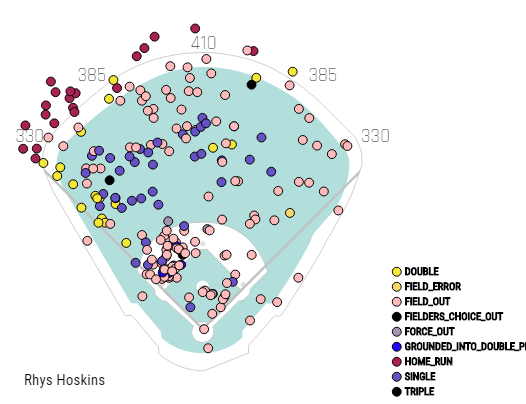
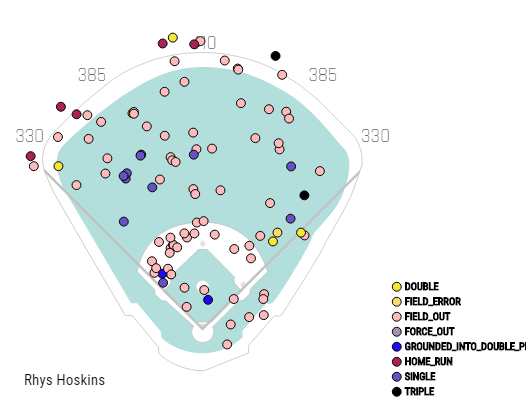
The main difference that stands out between these two graphics is where his home runs are hit. Hoskins did not hit a single opposite-field homer in the first half. Now he’s hitting the ball to right field more often and he still doesn’t have an opposite-field homer. In fact, of Hoskins’ 77 career homers, only two of them have left the park to right field.
Balls hit to the pull side are generally harder than those hit the other way, so if Hoskins is intentionally trying to go oppo, it’s no surprise that his slugging and hard Hit % have both tanked drastically. But let’s not rule out the possibility that Hoskins’ is getting pitched differently.
Pitch Location
Hoskins’ zone profiles from before and after the All-Star break look nearly identical. In the first half, Hoskins saw 47.5% of all pitches end in the strike zone and in the second half he has seen 47.3% of all pitches go for strikes. For clarification, I’m choosing to ignore Hoskins’ pitches outside the zone, since he has great plate discipline and is excellent at drawing walks. In both zone profiles, he is getting pitched predominately middle-away, indicated by the red squares. Take a look.
First half Second half
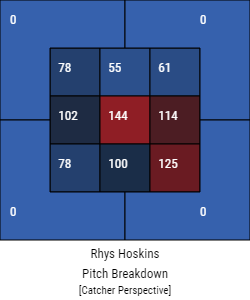
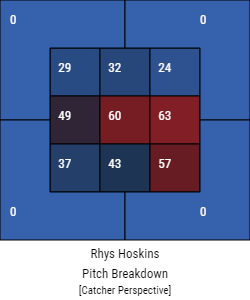
Clearly pitchers have not tried to pitch Hoskins differently in the second half. Hoskins is getting more pitches away than any other part of the zone, so maybe it is just his approach. Let’s see what he’s doing with these outer-third pitches.
First half Second half
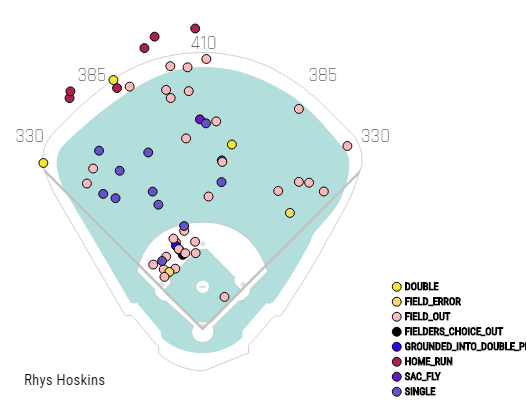
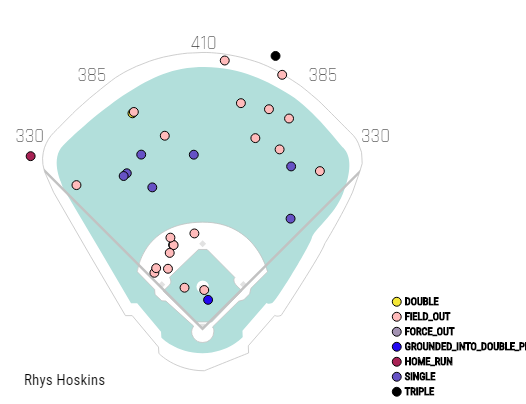
Of course the sample of batted balls is smaller, but you can still pretty clearly see a shift in where these balls are hit. We can even see this same trend in pitches that are just in the middle zones.
First half Second half
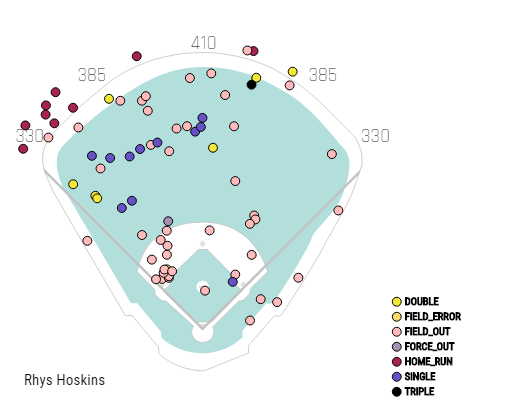
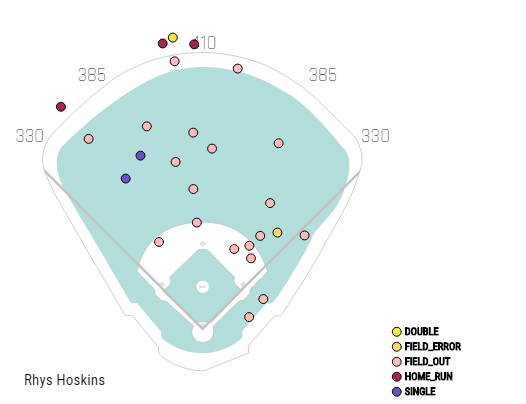
Again, a smaller sample size in the second half, but he is still clearly hitting less balls to left field and has shifted to hitting balls the other way. Hoskins was able to effectively hit these middle and outside strikes to the left-center gap with power, but has yet to be able to hit them to right-center and right field for power. Let’s look specifically at two instances of hitting the same pitch to a different location.
First half homer
https://gfycat.com/unsightlyambitiousiguana-baseball
Second half flyout
https://gfycat.com/naiveheartycardinal-baseball
These two instances don’t mean much, as I only handpicked them to show a difference, but it’s nice to be able to put video to the trend. Nonetheless, it looks like an approach that many people would probably deem as smart, is actually hurting the power hitter.
Pitch Type
The last factor I want to look at is what kind of pitches Hoskins has struggled to hit. Last season Hoskins posted the league’s 12th-best wFB, runs created against fastballs. In the first half of this season, Hoskins had the 26th-best wFB by producing a solid 11.9 runs. However, so far in the second half his wFB sits at an ugly -1.3 runs, the 39th-worst in the league. Hoskins has seen a drop in all of his pitch values in the second half, but none more than his wFB, showing second-half Hoskins is struggling big time to hit the heater. But maybe he’s just been unlucky? Let’s see what his expected stats say about his performance.
| xBA | xwOBA | xSLG | |
| Fastballs | 0.207 | 0.353 | 0.430 |
| Offspeeds | 0.168 | 0.201 | 0.218 |
| Breaking | 0.134 | 0.265 | 0.235 |
Welp, it doesn’t get much prettier.
What to Make of This
Hoskins’ struggle to pull the ball is a strange phenomenon for a hitter who has built his hitting style on being a pull-side power hitter. But we have also recently seen this trend with Yankees star Aaron Judge. Judge did not hit an overall skid like Hoskins has, but until recently, Judge wasn’t pulling the ball with power. So it may not be far fetched to say that Hoskins can make the same adjustment.
As for the struggle to hit fastballs, maybe it’s simply a timing issue that is keeping him from squaring up the baseball. Maybe there’s even an underlying injury we don’t know about … but let’s hope not. Because of Hoskins’ career tendency to pull the baseball and crush fastballs, I wouldn’t count him out from rebounding in the last 30 games. But the batted ball metrics don’t favor him and we’re getting to the point where fantasy baseball playoffs are starting to begin.
If I had to give a distinct explanation as to why Hoskins has struggled mightily in the second half, I would say this: Hoskins has been making weaker contact all season and now he’s hitting more balls in the air than ever before. These batted balls in the air simply aren’t hit hard enough to result in a positive outcome. This trend is negatively affecting Hoskins’ overall offensive production, making it hard for him to get knocks. For the power, Hoskins just isn’t pulling the ball enough to be able to produce the same rate of home runs he did in the first half. Pulling the ball is key to Hoskins regaining his power stroke.
If you’re a Hoskins owner, like I am, I would recommend you hold on to him but also look for a waiver wire option to give more playing time to while Hoskins figures it out. Mark Canha, Ryan McMahon, Eric Thames, Luis Arraez, Mike Ford, and Josh VanMeter are some guys with either 1B or OF eligibility that may be able to help you out.
Featured Image by Justin Paradis (@freshmeatcomm on Twitter)

Good article, Kyle!
Pulled fly balls are a bit of catch-22. On one hand, they are the most valuable type of batted ball given how hard they are usually hit. But when a player sells out for them, the rest of their profile tends to sag (more whiffs, pop-ups, and weakly hit grounders). Often these hitters will only be able to hit fastballs well, a sign that they’re going up with a guess-hitting style.
The jury is out on where Hoskins goes from here. His increased opposite-field tendencies are probably a good thing (golfing those low and outside pitches for home runs is not sustainable). But I’m not convinced he’s more than a guess hitter at this point.
Thanks Nick! You bring up a good point about the sustainability and that’s something I should’ve put more thought into. It totally makes sense that he should stop trying to pull those balls so that it benefits himself in the longterm but I also think he’s a guy that could be strong enough to get away with it (like many guys are). Being a guy that has had to try to fight with developing an approach in hitting, I strongly believe that all MLB hitters are somewhat guess hitters. I don’t think Trout ever goes up there looking for one pitch (of course he may in some small instances), but rather looking for a zone and naturally adjusting to the speed if it’s in his zone. I think hitting is way too hard if you’re looking for specifically one pitch, but then again these are the best in the world so maybe the can do what I can’t!